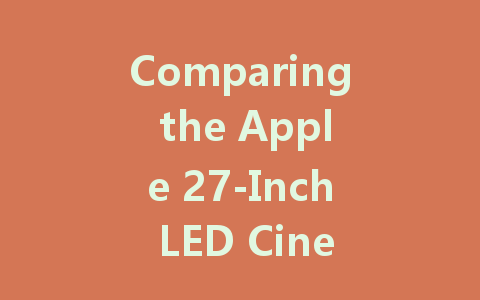
In the realm of high-quality displays, Apple has consistently impressed users with its premium offerings. Among these, the Apple 27-Inch LED Cinema Display and the Thunderbolt Display stand out for their sleek designs and impressive specifications. If you’re in the market for one of these monitors but are unsure which one to choose, read on as we break down their features, differences, and ideal use cases.
Overview of the Displays
Apple 27-Inch LED Cinema Display
Launched in 2010, the Apple 27-Inch LED Cinema Display was a game-changer for creatives and professionals alike. Featuring a beautiful 2560 x 1440 resolution, the display showcases stunning visuals, making it perfect for tasks like photo editing and video production. With an incredibly accurate color representation due to its IPS panel technology, users can expect vibrant colors and deep blacks.
Thunderbolt Display
Following its predecessor, the Thunderbolt Display was released as an upgrade to the LED Cinema Display. This monitor maintained the same impressive size and resolution but included several enhancements. The Thunderbolt port allows for faster data transfer speeds and the ability to daisy-chain multiple displays. Like the Cinema Display, it also boasts an IPS panel for superior color accuracy and wider viewing angles, making it another solid choice for creative professionals.
Key Features Comparison
Resolution and Image Quality
Both displays boast a stunning 2560 x 1440 resolution, allowing for crisp and detailed images. However, the Thunderbolt Display excels with a brighter display and better handling of color depth. The enhanced contrast ratios provided by the Thunderbolt’s upgraded technology make it a fantastic option for designers who demand precision in their work.
Connectivity Options
One of the most significant differences lies in the connectivity options. The Apple 27-Inch LED Cinema Display features a Mini DisplayPort, which provides video and audio output but lacks the versatility of newer standards. Conversely, the Thunderbolt Display employs a Thunderbolt port, offering superior data transfer speeds and the ability to connect multiple devices, such as external hard drives and additional monitors, without requiring multiple cables.
Built-in Features
The Thunderbolt Display includes several built-in features that enhance its usability. It offers a FaceTime HD camera, high-fidelity speakers, and a Thunderbolt hub with three USB 2.0 ports. These integrated aspects streamline the user experience, reducing desk clutter and enhancing functionality. The 27-Inch LED Cinema Display, while still impressive, lacks these additional amenities, making the Thunderbolt a more convenient choice for many users.
Performance and Use Cases
Creative Work
For professionals in photography, videography, or graphic design, both displays perform exceptionally well due to their color accuracy and resolution. However, the Thunderbolt Display’s enhanced connectivity and improved brightness make it a better fit for those requiring precise color reproduction and versatile connectivity.
Gaming and Entertainment
While both displays are primarily aimed at professionals, casual gamers and those who watch movies will benefit from the high resolution and sharp visuals. However, users should consider the Thunderbolt Display’s slight edge in performance and connectivity options for a more immersive experience.
General Office Work
For everyday tasks like Microsoft Office applications, web browsing, and video conferencing, either display will serve adequately. Personal preferences, such as design or budget constraints, may dictate the choice. The LED Cinema Display might appeal to users looking for a more affordable option without sacrificing too much in terms of performance and aesthetics.
Final Thoughts
Choosing between the Apple 27-Inch LED Cinema Display and the Thunderbolt Display ultimately boils down to your specific needs and use cases. If you prioritize advanced connectivity and additional built-in features, the Thunderbolt Display is the clear winner. On the other hand, if you’re looking for a more affordable option that still delivers excellent performance, the 27-Inch LED Cinema Display can be a reliable choice.
Both displays offer impressive visuals and color fidelity, making either a worthwhile investment, especially for creatives. However, for those who work with demanding visual content or require extensive connectivity, the Thunderbolt Display’s additional features and capabilities offer significant advantages. Ultimately, the better display will be the one that fits seamlessly into your workflow and meets your specific demands.